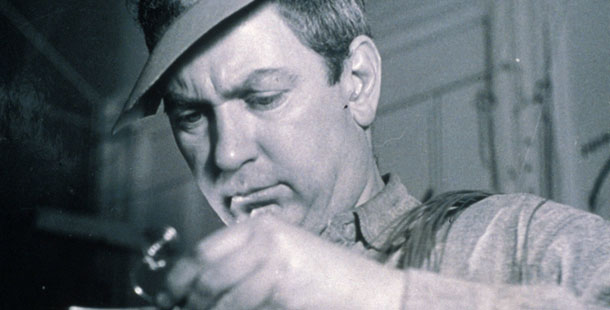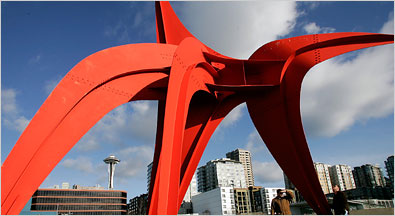إعادة الموضوع

وُلِد الفنان الكسندر كالدر عام 1898 في ولاية بنسلفانيا الأميركية وتوفي في 1979 من أب نحّات وأم رسامة شجعا ميوله الإبداعية ودرّباه على القواعد والمصطلحات الفنية. بعد دراسة الهندسة في جامعة نيو جرسي، سينتقل من مهنة الى أخرى قبل أن يقرر تكريس حياته للرسم. من عام 1923 وحتى عام 1926، سيتابع دروساً في الرسم في نيويورك ويكسب عيشه من عمله كرسّام هزلي في مجلة National Police Gazette التي سيُحقق فيها أيضاً ريبورتاجه المصوّر حول السيرك. ومن المؤكد أن افتتانه بهذا الأخير يعود الى تلك الفترة. وفي كتابه Animal Sketching الذي يضم سلسلة رسومه المنفّذة في حديقة الحيوانات التي كان يتردد عليها آنذاك، تجسّد هذه الرسوم ذات الخط المتواصل مقدّماً شريط الحديد الذي سيعمل به لاحقاً ويستخدمه كما لو أنه رسم في الفضاء... بيد مرفوعة
عام 1926، يعرض كالدر أولى لوحاته الزيتية في نيويورك ويختبر فن النحت على الخشب والحديد، قبل أن يرحل الى باريس حيث يتابع دروساً ويشارك في صالون المستقلين. خلال تلك الفترة، يبتكر لعباً متحرّكة الأعضاء بواسطة شريط حديد. ومن وسيلة تشكيل، سيصبح هذا الشريط مستقلاً فيعطي للمنحوتة حياة ذاتية. من هنا أيضاً فكرة السيرك المصغّر المؤلّف من فيلة وأحصنة وأسود مشغولة بواسطة شريط حديد وقطع خشب ومطاط وقماش مفصّلة. وسيصبح هذا السيرك الذي سيدخل عليه وجوهاً جديدة بين عامي 1927 و1930، المختبر الذي ستتبلور فيه معظم خصوصيات فن كالدر. عام 1928، يعرض للمرة الأولى شخصياته الكاريكاتورية في نيويورك ثم في باريس عام 1929، فيعرف شهرة لكن كفنان هزلي خصوصاً. بموازاة ذلك، يستمر في تشغيل سيركه المصغّر فيقدّم بنفسه عروضاً مليئة بالفكاهة والسخرية في نيويورك وباريس وبرلين. وستشكل هذه العروض مناسبة له للتعرّف على شخصيات مهمة من المحيط الفني الباريسي، مثل خوان ميرو الذي سيصبح صديقه وفرنان ليجي ولو كوربوزيي وموندريان...

عام 1930، سيزور كالدر محترف موندريان فيتأثر بشكل كبير بهندسته الداخلية كما سيتأثر بشخصية ذلك العملاق الآخر. إذ سيصرّح بنفسه أن هذا اللقاء كان الحافز الذي دفعه الى دخول حقول الفن التجريدي. عام 1931، يتعرف في باريس على هانز آرب وجان هيليون فيُدخلانه الى مجموعة Abstraction-Cr?ation. وفي ذلك الحين، سيبدأ بالعمل على منحوتات مجرّدة يدخِل عليها اللون للمرة الأولى وتبدو مستوحاة من طبيعة تنظيم الكون. وستفاجئ هذه المنحوتات التي سيعرضها في باريس زوار المعرض نظراً لاعتباره دائماً كفنان هزلي. إذ سيكتب ليجي عنها: أمام هذه الأعمال الجديدة الشفافة والموضوعية والدقيقة، أفكّر بإريك ساتي، وموندريان ومرسيل دوشان وبرانكوزي وآرب، معلّمي الجمال الصامت وغير المعبّر.
وكجميع النحاتين سيؤخذ كالدر بالتعبير عن الحركة. وإذا تشكّل شخصياته الصغيرة المتحرّكة والمصنوعة من شريط حديد شهادة باكرة على هذا الاهتمام، إلا أنه سيعرض أولى متحرّكاته (Les mobiles)، كما سيدعوها مارسيل دوشان، والتي تنخرط داخل حقل التجريد، في غاليري فينيون الباريسية عام 1932. لكن حركة هذه المنحوتات بقيت خاضعة لمُحرّك أو مُدوّرة (manivelle)، الأمر الذي لم يرضِ الفنان فتخيّل، منذ عام 1932، وللمرة الأولى في تاريخ فن النحت، الوسيلة للتعبير عن الحركة الطبيعية والذاتية من خلال ابتكاره لأعمال فنية تتحرك عناصرها بفعل تنقل الهواء، بحرية كاملة وتبعاً لإيقاعها الذاتي، مما يوحي بحركة جسم حي. وتتألف هذه المنحوتات من مواد صناعية، معدنية بشكل رئيسي، وتشير الى الحياة العضوية كما تقع داخل ذلك العالم الذي تطفو فيه الأشياء والكائنات، تماماً كما في لوحات خوان ميرو. وسترتكز جميع أعماله النحتية اللاحقة على هذا المبدأ ـ القاعدة، كما تشهد عليه منحوتة ينبوع عطارد التي حققها عام 1937. ويقول كالدر في هذا السياق: المتحرّك هو قصيدة ترقص على وقع مرح الحياة ومفاجآتها. وعام 1937، ستظهر أيضاً منحوتاته الثابتة التي سيُطلق عليها هانز آرب تسمية (stabiles) نظراً الى جمودها وتثبيتها في الأرض. وتتجسّد طاقتها الحركية في مسعى المشاهد المُجبَر على الدوران حولها للإحاطة بها.
وبين عامي 1933 و1944، يستقر الفنان في مقاطعة روكسبوري الأميركية فيعرض بشكل منتظم في غاليري بيار ماتيس ويقيم علاقات ثابتة مع فنانين مثل جايمس سويني. ومنذ بداية الأربعينات، سيكسب شهرة عالمية كما سيُجسّد اهتمامه بنظام الكون عبر سلسلة أعمال تحمل تسمية (constellations) وتتألف من قطع خشبية مختلفة الأشكال مربوطة ببعضها البعض بواسطة عيدان فولاذية صلبة. عام 1945، يخصص متحف نيويورك للفن الحديث معرضاً استعادياً له يتبعه معرض كبير في غاليري فْْج الباريسية عام 1946.

وينخرط إنتاج الأصوات ضمن أبحاث كالدر منذ عام 1932، إذ تستخدم سلسلة أعماله التي تحمل عنوان (Gongs)، والتي طوّرها عام 1948، الحركة العشوائية لعناصر كل منحوتة من أجل خلق أصوات مختلفة. ومنذ بداية الخمسينات، سيكبر حجم أعماله، خصوصاً حين يتعلّق الأمر بطلبيات مرصودة لباحات فسيحة أو لفضاءات بيئية. ما سيحقق أبراجاً هي عبارة عن منحوتات متحركة وثابتة في آن واحد، تشبه في بنيتها سلسلة tions). وعام 1953، سيشتري مزرعة قرب مدينةئئ
(constella Tour الفرنسية حيث سيستقر منذ عام 1960، الى جانب مكوثه في روكسبوري. ويجب انتظار فترة الستينات كي ينشط بشكل كثيف في تحقيق محفورات وسجادات ولوحات بمادة الغواش الى جانب عمله المعتاد. عام 1956، ينظم متحف غوغنهايم الشهير في نيويورك معرضاً استعادياً له يتبعه في العام ذاته معرض آخر في متحف الفن الحديث في باريس. بعد ذلك، سينفذ سلسلة الطواطم (les Totems) عام 1968، وهي منحوتات تتميّز بأشكال جديدة هرمية عالية وسوداء يعلوها أكاليل متحركة على شكل رؤوس، كما سيحقق باليه عام 1968 لدار الأوبرا في روما تحت عنوان Work in progress. وسيستمر الفنان في نشاطه الى حين وفاته في نيويورك عام 1976.

وُلِد الفنان الكسندر كالدر عام 1898 في ولاية بنسلفانيا الأميركية وتوفي في 1979 من أب نحّات وأم رسامة شجعا ميوله الإبداعية ودرّباه على القواعد والمصطلحات الفنية. بعد دراسة الهندسة في جامعة نيو جرسي، سينتقل من مهنة الى أخرى قبل أن يقرر تكريس حياته للرسم. من عام 1923 وحتى عام 1926، سيتابع دروساً في الرسم في نيويورك ويكسب عيشه من عمله كرسّام هزلي في مجلة National Police Gazette التي سيُحقق فيها أيضاً ريبورتاجه المصوّر حول السيرك. ومن المؤكد أن افتتانه بهذا الأخير يعود الى تلك الفترة. وفي كتابه Animal Sketching الذي يضم سلسلة رسومه المنفّذة في حديقة الحيوانات التي كان يتردد عليها آنذاك، تجسّد هذه الرسوم ذات الخط المتواصل مقدّماً شريط الحديد الذي سيعمل به لاحقاً ويستخدمه كما لو أنه رسم في الفضاء... بيد مرفوعة
عام 1926، يعرض كالدر أولى لوحاته الزيتية في نيويورك ويختبر فن النحت على الخشب والحديد، قبل أن يرحل الى باريس حيث يتابع دروساً ويشارك في صالون المستقلين. خلال تلك الفترة، يبتكر لعباً متحرّكة الأعضاء بواسطة شريط حديد. ومن وسيلة تشكيل، سيصبح هذا الشريط مستقلاً فيعطي للمنحوتة حياة ذاتية. من هنا أيضاً فكرة السيرك المصغّر المؤلّف من فيلة وأحصنة وأسود مشغولة بواسطة شريط حديد وقطع خشب ومطاط وقماش مفصّلة. وسيصبح هذا السيرك الذي سيدخل عليه وجوهاً جديدة بين عامي 1927 و1930، المختبر الذي ستتبلور فيه معظم خصوصيات فن كالدر. عام 1928، يعرض للمرة الأولى شخصياته الكاريكاتورية في نيويورك ثم في باريس عام 1929، فيعرف شهرة لكن كفنان هزلي خصوصاً. بموازاة ذلك، يستمر في تشغيل سيركه المصغّر فيقدّم بنفسه عروضاً مليئة بالفكاهة والسخرية في نيويورك وباريس وبرلين. وستشكل هذه العروض مناسبة له للتعرّف على شخصيات مهمة من المحيط الفني الباريسي، مثل خوان ميرو الذي سيصبح صديقه وفرنان ليجي ولو كوربوزيي وموندريان...

عام 1930، سيزور كالدر محترف موندريان فيتأثر بشكل كبير بهندسته الداخلية كما سيتأثر بشخصية ذلك العملاق الآخر. إذ سيصرّح بنفسه أن هذا اللقاء كان الحافز الذي دفعه الى دخول حقول الفن التجريدي. عام 1931، يتعرف في باريس على هانز آرب وجان هيليون فيُدخلانه الى مجموعة Abstraction-Cr?ation. وفي ذلك الحين، سيبدأ بالعمل على منحوتات مجرّدة يدخِل عليها اللون للمرة الأولى وتبدو مستوحاة من طبيعة تنظيم الكون. وستفاجئ هذه المنحوتات التي سيعرضها في باريس زوار المعرض نظراً لاعتباره دائماً كفنان هزلي. إذ سيكتب ليجي عنها: أمام هذه الأعمال الجديدة الشفافة والموضوعية والدقيقة، أفكّر بإريك ساتي، وموندريان ومرسيل دوشان وبرانكوزي وآرب، معلّمي الجمال الصامت وغير المعبّر.
وكجميع النحاتين سيؤخذ كالدر بالتعبير عن الحركة. وإذا تشكّل شخصياته الصغيرة المتحرّكة والمصنوعة من شريط حديد شهادة باكرة على هذا الاهتمام، إلا أنه سيعرض أولى متحرّكاته (Les mobiles)، كما سيدعوها مارسيل دوشان، والتي تنخرط داخل حقل التجريد، في غاليري فينيون الباريسية عام 1932. لكن حركة هذه المنحوتات بقيت خاضعة لمُحرّك أو مُدوّرة (manivelle)، الأمر الذي لم يرضِ الفنان فتخيّل، منذ عام 1932، وللمرة الأولى في تاريخ فن النحت، الوسيلة للتعبير عن الحركة الطبيعية والذاتية من خلال ابتكاره لأعمال فنية تتحرك عناصرها بفعل تنقل الهواء، بحرية كاملة وتبعاً لإيقاعها الذاتي، مما يوحي بحركة جسم حي. وتتألف هذه المنحوتات من مواد صناعية، معدنية بشكل رئيسي، وتشير الى الحياة العضوية كما تقع داخل ذلك العالم الذي تطفو فيه الأشياء والكائنات، تماماً كما في لوحات خوان ميرو. وسترتكز جميع أعماله النحتية اللاحقة على هذا المبدأ ـ القاعدة، كما تشهد عليه منحوتة ينبوع عطارد التي حققها عام 1937. ويقول كالدر في هذا السياق: المتحرّك هو قصيدة ترقص على وقع مرح الحياة ومفاجآتها. وعام 1937، ستظهر أيضاً منحوتاته الثابتة التي سيُطلق عليها هانز آرب تسمية (stabiles) نظراً الى جمودها وتثبيتها في الأرض. وتتجسّد طاقتها الحركية في مسعى المشاهد المُجبَر على الدوران حولها للإحاطة بها.
وبين عامي 1933 و1944، يستقر الفنان في مقاطعة روكسبوري الأميركية فيعرض بشكل منتظم في غاليري بيار ماتيس ويقيم علاقات ثابتة مع فنانين مثل جايمس سويني. ومنذ بداية الأربعينات، سيكسب شهرة عالمية كما سيُجسّد اهتمامه بنظام الكون عبر سلسلة أعمال تحمل تسمية (constellations) وتتألف من قطع خشبية مختلفة الأشكال مربوطة ببعضها البعض بواسطة عيدان فولاذية صلبة. عام 1945، يخصص متحف نيويورك للفن الحديث معرضاً استعادياً له يتبعه معرض كبير في غاليري فْْج الباريسية عام 1946.

وينخرط إنتاج الأصوات ضمن أبحاث كالدر منذ عام 1932، إذ تستخدم سلسلة أعماله التي تحمل عنوان (Gongs)، والتي طوّرها عام 1948، الحركة العشوائية لعناصر كل منحوتة من أجل خلق أصوات مختلفة. ومنذ بداية الخمسينات، سيكبر حجم أعماله، خصوصاً حين يتعلّق الأمر بطلبيات مرصودة لباحات فسيحة أو لفضاءات بيئية. ما سيحقق أبراجاً هي عبارة عن منحوتات متحركة وثابتة في آن واحد، تشبه في بنيتها سلسلة tions). وعام 1953، سيشتري مزرعة قرب مدينةئئ
(constella Tour الفرنسية حيث سيستقر منذ عام 1960، الى جانب مكوثه في روكسبوري. ويجب انتظار فترة الستينات كي ينشط بشكل كثيف في تحقيق محفورات وسجادات ولوحات بمادة الغواش الى جانب عمله المعتاد. عام 1956، ينظم متحف غوغنهايم الشهير في نيويورك معرضاً استعادياً له يتبعه في العام ذاته معرض آخر في متحف الفن الحديث في باريس. بعد ذلك، سينفذ سلسلة الطواطم (les Totems) عام 1968، وهي منحوتات تتميّز بأشكال جديدة هرمية عالية وسوداء يعلوها أكاليل متحركة على شكل رؤوس، كما سيحقق باليه عام 1968 لدار الأوبرا في روما تحت عنوان Work in progress. وسيستمر الفنان في نشاطه الى حين وفاته في نيويورك عام 1976.


















